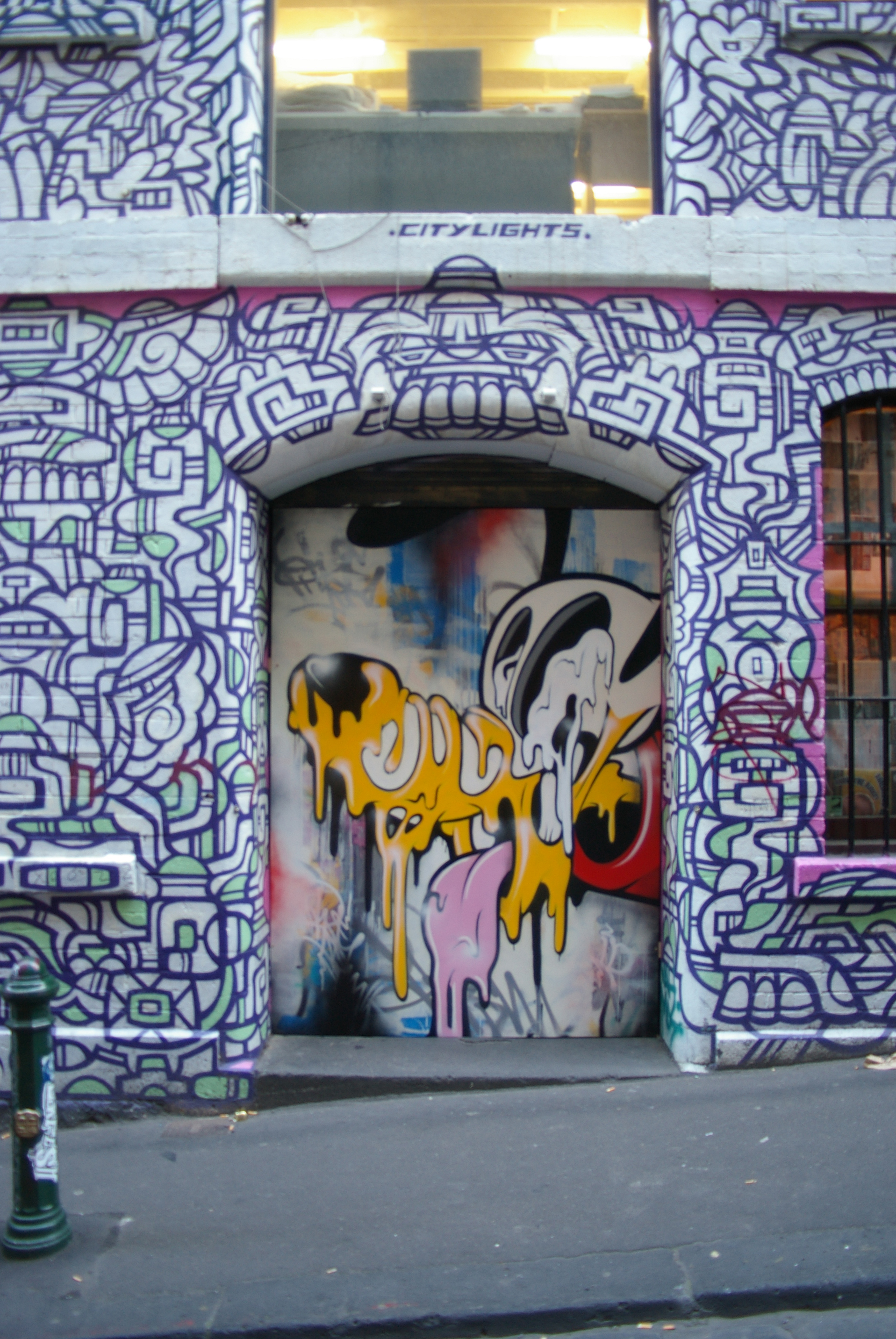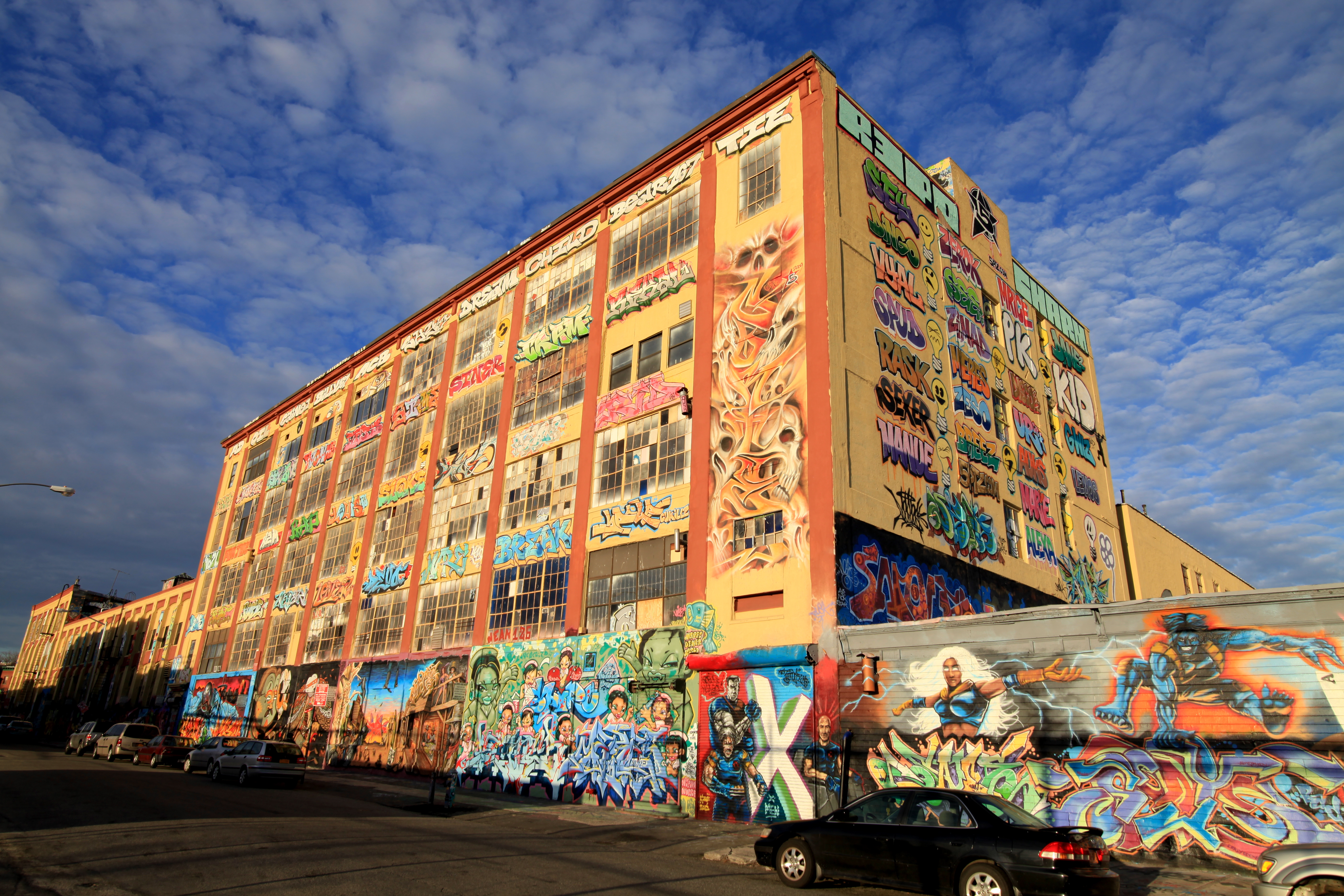Street Art vs. Graffiti: History, Techniques, and 20 Key Works (1967–Today)
A student’s guide to definitions, the street art timeline, tools & materials, landmark artworks, legal frameworks, and where to see it.
Street art history and the long debate over street art vs graffiti are best understood together: both happen in public space, both speak in bold images and letters, and both evolved from late-1960s tagging into a global visual culture. Following Tate, this guide distinguishes the broader field of street art (stencils, paste-ups, murals, interventions) from graffiti writing (stylized signatures, throw-ups, pieces) without denying their overlap. You’ll find a clear street art timeline from 1967 to today, technique primers, and 20 key works—from Keith Haring’s subway drawings and Jean-Michel Basquiat’s SAMO to Shepard Fairey’s “HOPE” poster—plus an explainer of the 5Pointz VARA decision.
Use this as a fast reference for classes, museum visits, or for anyone asking what is street art and how it differs from graffiti.

Quick Definitions: What Counts as Street Art? What Counts as Graffiti?
Street art is a broad set of public-space practices—often unsanctioned—using media such as stencils, wheatpaste posters, stickers, and large murals. It prioritizes imagery and messages legible to general audiences and can include site-specific installations. See Tate’s concise overview of street art.
Graffiti (often “writing”) centers on names/letters, evolving from tags to throw-ups and elaborate pieces within a subculture that values style, placement, and “going all-city.” For a short definition, compare Tate’s entry on graffiti art, then browse a community glossary for context such as UP Magazine’s terminology list.
- Overlap: public walls and transit; bold color; pseudonyms; photo circulation.
- Differences: imagery vs. lettering focus; audience outreach vs. insider codes; broader media vs. aerosol-centric traditions.
Street Art Timeline (1967 → Today): A Student’s Overview
1965–1971: Philadelphia to NYC
Many origin stories cite two catalysts. In late-1960s Philadelphia, Cornbread famously tagged his name around the city; Smithsonian Magazine recaps the lore and early documentation (read Smithsonian). In 1971, TAKI 183 became a household name when the New York Times profiled his omnipresent tag, spurring a wave of “all-city” ambitions on subways and streets (see the often-cited NYT feature referenced across histories).
1970s–1980s: Subways, Wild Style & Galleries
By the late 1970s, painted trains and handstyles defined New York’s visual soundtrack. The hip-hop era’s films and photography—think Style Wars—documented the scene, while artists like Keith Haring chalked quick figures on unused subway ad panels and Jean-Michel Basquiat signed SAMO tags before turning to studio canvases. A 1984 New Yorker piece, “Up from the I.R.T.,” tracked this crossover into galleries and the market (read the article).
1990s–2000s: Global Spread
With train systems cleaned and policing intensified, practices diversified and spread. Berlin’s post-1990 walls became large-scale stages; Melbourne’s laneways—especially Hosier Lane—grew into celebrated legal sites that refresh constantly.

2011: Museums Take Stock
Los Angeles MOCA’s landmark exhibition Art in the Streets (2011) surveyed the movement’s arc from 1970s writing to contemporary interventions, reframing public perceptions (see MOCA).
2010s–2020s: From Walls to Policy & Preservation
The 5Pointz warehouse complex in Queens became both icon and legal touchstone when whitewashed and demolished; in 2020, the U.S. Second Circuit affirmed significant damages under the Visual Artists Rights Act (VARA) for destroying aerosol works of “recognized stature” (read the decision). Conservation also matured as a field, with the Getty Conservation Institute publishing guidance on outdoor murals and graffiti removal challenges (Getty resources).
Techniques & Materials
Spray Paint & Nozzles
Aerosol is fast and portable. Swapping caps changes line weight from ultra-thin outlines to fat fills; fades and blends create dimensional letters or gradients. Gloss vs. matte and brand differences affect coverage and UV durability.
Stencil Art
Cut templates enable crisp edges and rapid repetition—ideal for visual slogans and political messages. Multiplying layers can build color separations and depth; stencils scale from postcard stickers to building-height murals.
Wheatpaste & Paste-Ups
Wheatpaste is a starch-and-water adhesive brushed on walls for paper posters and collages—quick, inexpensive, and suited to graphic campaigns and illustration-heavy works. For a compact materials overview, see Smarthistory’s material glossary (glossary).
Stickers & Slap Tags
Pre-printed or hand-drawn stickers travel in pockets and packages, spreading a mark or character globally. They serve as mini-billboards and connect scenes through trades and mail art.
Large Murals
Lift work, acrylics, mineral paints, and protective coatings meet the scale of civic walls. Outdoors, UV, rain, and freeze–thaw cycles are constant threats; the Getty Conservation Institute documents approaches and debates around protection vs. patina (Getty on murals).
At a Glance: Reading Materials & Methods
- Spray Lines, fills, fades; cap control.
- Stencil Repetition, layered color, fast deployment.
- Wheatpaste Posters/collage; low-cost and bold.
- Stickers Portable identity; trading networks.
- Murals Lifts, large brushes, site planning, coatings.
Visual Grammar & Influences
Look closely and you’ll see echoes of earlier movements. Compressed typography, diagonals, and photomontage logic resonate with the Constructivist toolbox of dynamic composition and sans-serif structure. Pared-down color blocking recalls the ideals of De Stijl’s geometry and restraint—see our De Stijl context for a side-by-side comparison. High-contrast patterns and moiré-like illusions often flirt with Op Art’s “vibration” effects (related reading below).
12 Artists & 20 Key Works to Know
Keith Haring moved from chalk subway drawings to public murals that remain civic landmarks. Pisa’s Tuttomondo (1989) blends joyful figures with social symbolism; his activism-inflected murals turned subways into classrooms.
Jean-Michel Basquiat bridged street and studio. Early SAMO tags set a tone of poetic critique; in the 1980s, paintings such as Hollywood Africans (see Whitney collection) exposed race, celebrity, and economics through raw line and language.
Shepard Fairey harnessed stencils and paste-ups into a global poster language, culminating in the Obama “HOPE” image later collected by the Smithsonian’s National Portrait Gallery (NPG on HOPE).
Lady Pink foregrounded women’s presence in a male-dominated scene, painting trains and walls with narrative power that continues to influence festival murals and institutional commissions.
Futura (formerly Futura 2000) abstracted letterforms into cosmic gestures; Lee Quiñones pioneered full-car narratives that later entered museums (see MoMA exhibition histories). Os Gemeos (Brazil) developed yellow-toned characters that bridge folklore and pop; JR scaled photography into city-sized portraits; Invader tiled pixels into urban space; Blu animated paint into politically charged mega-murals; Swoon carved human-scale empathy into cut-paper figures installed worldwide.
Key Case Study: Subways to Museums
MoMA Magazine’s writing on Martin Wong illuminates how painting, writing, and community histories interwove—bridging street culture and gallery contexts (read MoMA Magazine).
Law, Ethics & the 5Pointz Precedent
Public walls involve property, permission, and local statutes. While many murals are commissioned or sanctioned, unauthorized painting can be treated as vandalism. This section is informational—not legal advice—and points to a crucial U.S. case.
VARA (1990) grants moral rights to certain works of visual art in the U.S., including the right of attribution and, for works of “recognized stature,” the right to prevent intentional destruction. In Castillo v. G&M Realty (2020), the Second Circuit affirmed that temporary aerosol works at 5Pointz could qualify as works of recognized stature and upheld statutory damages (case text).

Ephemerality & Conservation
Outdoor works change. Sunlight, pollution, moisture, and temperature cycles break down binders and pigments; surface prep and substrate matter. Conservation teams weigh whether to intervene at all (respecting intent and community) and how to stabilize surfaces if they do. The Getty Conservation Institute’s newsletters and mural projects offer accessible primers on deterioration, documentation, and cleaning ethics—especially where graffiti removal risks collateral damage (browse Getty).
How to Read Street Art (for visitors & students)
- Site: Why this wall? Consider neighborhood history and viewer flow.
- Message: Is it a name, a character, a slogan, a memorial?
- Medium: Spray, stencil, paste-up, sticker, or brush mural?
- Audience: Insider code or broad outreach?
- Etiquette: Photograph safely, don’t block sidewalks or traffic, and include context (surroundings help tell the story).
Where to See It (Starter List)
- Melbourne, Australia: Hosier Lane’s legal laneway refreshes weekly—stencils, paste-ups, murals.
- Berlin, Germany: Mitte and Friedrichshain host walls that mix post-1990 history with today’s festivals.
- Philadelphia, USA: Mural Arts turns city walls into classrooms; debates about origins linger (see Streets Dept. for local insights).
- New York City, USA: Bushwick and Harlem for current walls; historically, MOCA’s 2011 survey galvanized discussion of museums and streets.
FAQs
- What’s the difference between street art and graffiti?
- Street art is a broad set of public-space practices (stencils, paste-ups, murals) often unsanctioned; graffiti is a writing subculture focused on stylized names/letters. Both happen in public; intent and media differ.
- Who “started” modern graffiti?
- Histories often cite Cornbread (late-1960s Philadelphia) and TAKI 183 (1971 New York Times article) as catalytic figures—while origins are debated.
- Is street art legal?
- Legality depends on permission and local law; unauthorized work can be vandalism.
- What techniques do street artists use?
- Spray paint, stencils, wheatpaste/paste-ups, and stickers; some artists paint large brush or acrylic murals.
- What is wheatpaste?
- A starch-and-water adhesive used to apply paper posters to walls; it’s quick, inexpensive, and common in paste-ups.
- Can street art be preserved?
- Outdoor works fade. Conservation choices weigh materials, environment, artist intent, and community; see Getty’s open resources.
- What was MOCA’s Art in the Streets?
- A major 2011 museum survey tracing graffiti and street art from the 1970s to the present.
- What is the 5Pointz case?
- A U.S. appeals court affirmed that aerosol art can have “recognized stature” under VARA—awarding damages after the site’s destruction.
- Who are some key street artists to know?
- Keith Haring, Jean-Michel Basquiat, Shepard Fairey, Lady Pink, Futura, Lee Quiñones, Os Gemeos, JR, Invader, Blu, and Swoon are widely cited.
- How should I photograph street art respectfully?
- Stay safe, don’t block pedestrians or traffic, and include wider context so the site and message remain clear.
Related Reading on Artoholica
Street visuals often borrow earlier modernist strategies. Explore our comparison of De Stijl vs. Constructivism for color blocking and diagonal structure, then browse our Art History + hub for Op Art’s optical ideas and other movements that echo on today’s walls.
Gentle Explore
Sources & Further Reading
- Tate—Art Terms: Street Art; Graffiti Art.
- MOCA Los Angeles—Art in the Streets (2011).
- Smithsonian National Portrait Gallery—Fairey’s Obama “HOPE”: object/blog.
- Getty Conservation Institute—Conservation newsletters; Mural projects.
- Second Circuit—Castillo v. G&M Realty (5Pointz, 2020).
- MoMA Magazine—Martin Wong and graffiti culture.
- The New Yorker (1984)—“Up from the I.R.T.”.
- Further reading (community/long-tail): Streets Dept.; UP Magazine terminology; art.art: Street Art 101.

0 commentaire